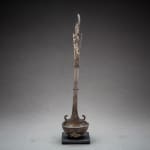Achaemenid/Greek Silver Ladle, 500 BCE - 400 CE
Silver
2 x 9
FZ.035
Further images
This ladle, termed a kyathos in Greek, is designed with a long, re-curved handle, rectangular in cross-section, which widens at the top to form a shoulder from which springs the...
This ladle, termed a kyathos in Greek, is designed with a long, re-curved handle, rectangular in cross-section, which widens at the top to form a shoulder from which springs the head of a duck which forms a finial. The elongated “neck” of the duck is curved to facilitate handling. The juncture of the handle with its rounded bowl is designed as two projecting tangs. It would seem this ladle was cast and then hammered with the details of the head of the duck chased.
Ladles of this design are attested in the Greek world from at least the eighth century B.C., although this utensil can be traced back to Mycenean times of the Bronze Age. During the Classical Period, the bowls of these ladles were designed to accommodate a specific quantity of liquid.
Scholars have inventoried a limited number of about a dozen ladles of this very type. These exhibit a specific geographic distribution pattern, most of the known examples coming from the area of northern Greece, north western Asia Minor, and South Russia along the coast of the Black Sea. All of these examples are dated to the late fourth to early third century B.C.
There are two very close parallels for our ladle; one in Baltimore, in The Walters Art Museum (inventory number 57.909) and a second in Minneapolis, The Minneapolis Institute of Arts (inventory number 72.104).
References:
A. Oliver, Jr., Silver for the Gods. 800 Years of Greek and Roman Silver (Toledo 1977), page 43, no. 13 and page 46, no. 15.
Ladles of this design are attested in the Greek world from at least the eighth century B.C., although this utensil can be traced back to Mycenean times of the Bronze Age. During the Classical Period, the bowls of these ladles were designed to accommodate a specific quantity of liquid.
Scholars have inventoried a limited number of about a dozen ladles of this very type. These exhibit a specific geographic distribution pattern, most of the known examples coming from the area of northern Greece, north western Asia Minor, and South Russia along the coast of the Black Sea. All of these examples are dated to the late fourth to early third century B.C.
There are two very close parallels for our ladle; one in Baltimore, in The Walters Art Museum (inventory number 57.909) and a second in Minneapolis, The Minneapolis Institute of Arts (inventory number 72.104).
References:
A. Oliver, Jr., Silver for the Gods. 800 Years of Greek and Roman Silver (Toledo 1977), page 43, no. 13 and page 46, no. 15.
Literature
V1





